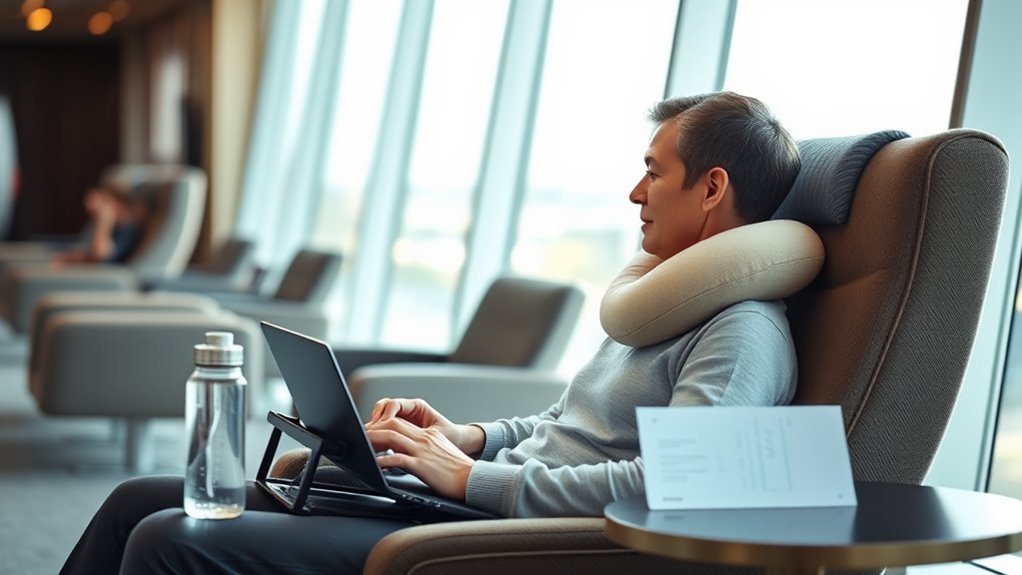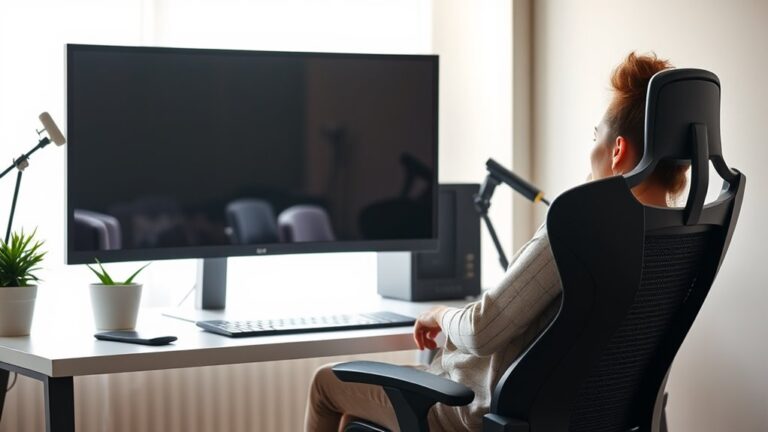To reduce tech neck and improve spine health while traveling, use ergonomic accessories like adjustable laptop stands and supportive travel pillows. Maintain awareness of your posture by aligning screens at eye level and taking regular breaks to stretch. Incorporate neck and back strengthening exercises, such as chin tucks and shoulder rolls, to combat discomfort. Don’t forget mindfulness techniques, like deep breathing, to alleviate stress. Discover more ways to enhance your travel experience and promote better posture.
Nomad Highlights
- Use supportive travel pillows to maintain proper neck alignment and reduce strain during travel.
- Adjust laptop stands to elevate screens to eye level, minimizing the need to look down.
- Engage your core while sitting to support the spine and improve overall posture.
- Take regular breaks to stand or stretch, helping reset posture and relieve stiffness.
- Incorporate mindfulness techniques, such as deep breathing, to alleviate tension and promote relaxation.
Understanding Tech Neck: Causes and Symptoms
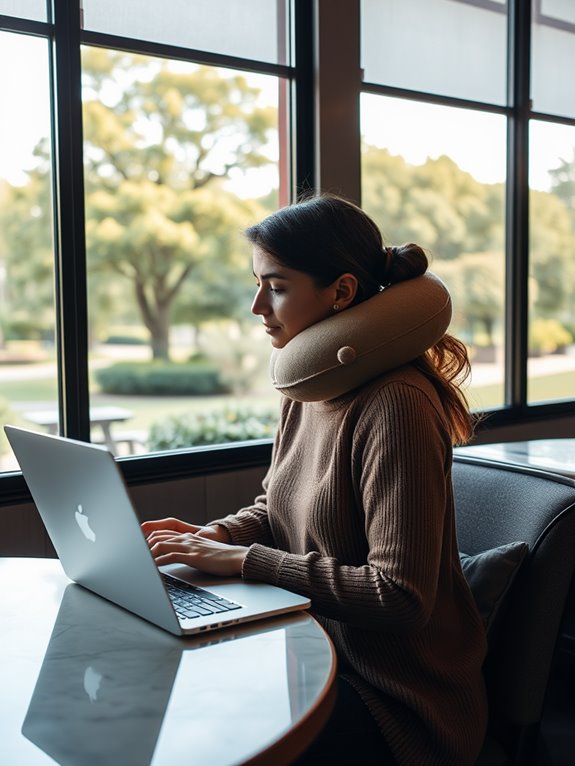
As you spend more time hunched over your devices, you may start to notice discomfort in your neck and shoulders—this is often referred to as tech neck.
This condition arises from prolonged periods of looking down at screens, causing strain on your cervical spine. Symptoms can include stiffness, headaches, and even tingling sensations in your arms. Regular use of blue light blocking glasses can help reduce eye strain and improve overall comfort while using devices. Furthermore, AI tools that assist in ergonomic assessment can help you identify optimal device positioning, promoting better posture. Incorporating handheld massagers into your routine can provide targeted relief for muscle tension and soreness caused by tech neck. Additionally, using massagers with multiple speed settings can enhance your relaxation experience.
While you might think it’s just a temporary discomfort, ignoring these signs can lead to chronic pain and posture issues.
Additionally, poor ergonomics in your workspace can exacerbate the problem, making it essential to recognize the signs early. Incorporating regular movement and continuous health monitoring can help mitigate the effects of prolonged device use.
Ergonomic Travel Accessories to Consider
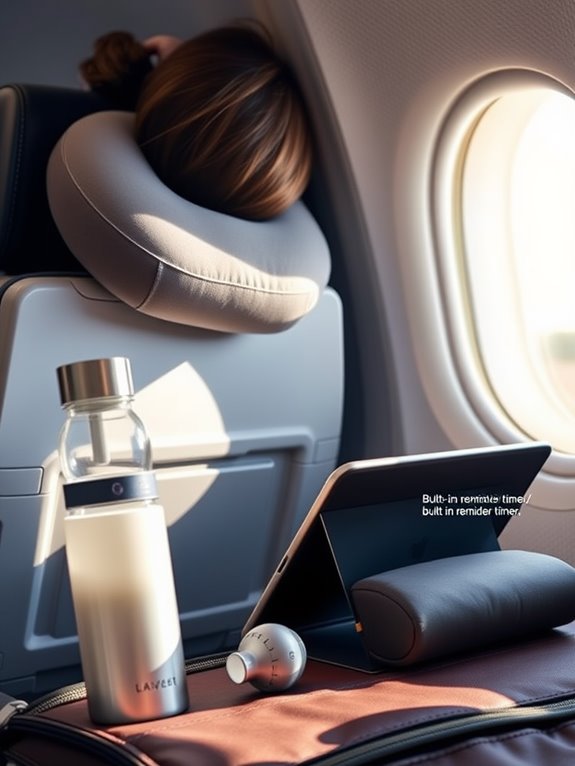
When you’re on the go, investing in ergonomic travel accessories can make a significant difference in preventing tech neck.
Start with a supportive travel pillow that cradles your neck, ensuring proper alignment during long flights or drives. An adjustable laptop stand can elevate your screen to eye level, reducing strain while you work. Incorporating ankle resistance bands in your travel routine can also help strengthen muscles and improve flexibility, making it easier to maintain good posture. Quality sleep masks, such as those with 3D contoured designs, can enhance your overall comfort during travel. Using a travel pillow with memory foam support can further enhance the comfort level by conforming to your neck shape. Additionally, consider high-density memory foam cushions that provide lasting comfort for your back while seated.
Consider noise-canceling headphones to block distractions, allowing you to maintain a comfortable posture without hunching over. A compact footrest can also help keep your feet flat and your back aligned while seated.
Finally, don’t forget a sturdy, padded backpack that distributes weight evenly, preventing shoulder strain. Additionally, using adjustable features in your travel accessories can further enhance comfort and support during your journey.
These accessories can enhance your comfort and promote better spine health throughout your travels.
Posture Awareness: Tips for Maintaining Alignment

Maintaining proper posture throughout your day can considerably reduce the risk of developing tech neck.
Being mindful of your alignment, especially while traveling, is essential. Here are some tips to keep you on track:
- Engage your core: A strong core supports your spine and encourages better posture. Additionally, using adjustable dumbbells during workouts can help strengthen your core muscles. Incorporating weight range options like those found in adjustable dumbbells will allow you to progressively challenge your core. This is vital for preventing injuries, as a strong core contributes to overall spine health.
- Align your screen: Position your device at eye level to avoid leaning forward or looking down.
- Keep your shoulders relaxed: Tension in your shoulders can lead to discomfort; roll them back and down periodically.
- Take breaks: Stand or stretch regularly to reset your posture and relieve any stiffness.
- Consider using an acupressure mat: These mats can enhance relaxation and promote muscle relaxation, which is beneficial for maintaining good posture during long periods of travel. Regular use can also reduce pain significantly, aiding in overall wellness.
Stretching Exercises to Alleviate Discomfort

In addition to being mindful of your posture, incorporating stretching exercises into your daily routine can considerably alleviate discomfort from tech neck.
Try neck tilts by gently dropping your ear to your shoulder, holding for 15 seconds on each side. Next, perform chin tucks by pulling your chin back towards your neck, holding for five seconds, and repeating ten times. Using a foam roller can also provide targeted pressure to help relieve tight muscles during your stretching routine. A compact foam roller can enhance muscle recovery by improving blood flow and mobility, which is essential for overall improved air quality.
Incorporate neck tilts and chin tucks into your routine to alleviate discomfort and improve posture.
Shoulder rolls can also help—simply roll your shoulders forward and backward in a circular motion for 30 seconds. Finally, stretch your upper back by clasping your hands and reaching forward, holding for 15 seconds. Doing these stretches regularly can improve flexibility and reduce tension, making your travels more comfortable and enjoyable. Additionally, consider using a compact foam roller to enhance muscle recovery and relieve tension after long periods of sitting.
Strengthening Your Neck and Back Muscles
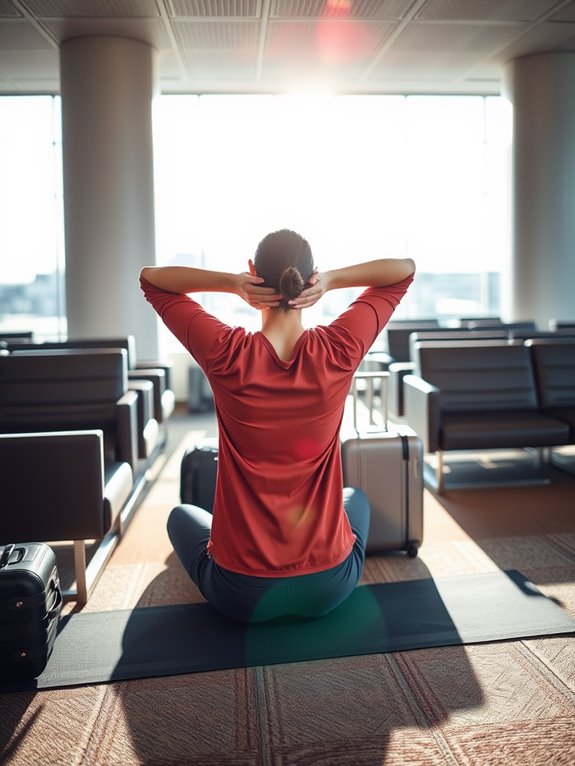
To combat tech neck, you need to strengthen your neck and back muscles. Incorporating neck strengthening exercises, back muscle workouts, and posture improvement techniques into your routine can make a real difference. Resistance bands can be a versatile tool to effectively target these muscle groups and enhance your workout experience. Additionally, using high-quality silicone resistance bands can ensure durability and provide consistent resistance, which is essential for effective training. Furthermore, incorporating resistance training can boost your metabolism by up to 15%, further supporting your overall health. Studies have shown that adjustable resistance levels in bands allow for tailored workouts, making it easier to progressively strengthen muscles. Suspension training kits, such as the Home Suspension Training Kit, offer additional versatility for your workouts and can help strengthen your core and back muscles effectively. Let’s explore how these practices can help support your spine and reduce discomfort.
Neck Strengthening Exercises
Strengthening your neck and back muscles is essential for combating tech neck and improving your overall posture. Incorporating simple neck exercises into your routine can greatly enhance your strength and flexibility.
Here are some effective exercises you can try:
- Neck Tilts: Gently tilt your head towards each shoulder, holding for a few seconds on each side.
- Chin Tucks: Pull your chin in towards your neck while keeping your shoulders relaxed, holding for a few seconds.
- Neck Rotations: Slowly rotate your head from side to side, ensuring you maintain a smooth motion.
- Resistance Band Exercises: Use a resistance band to perform gentle pulls, strengthening the neck muscles. Additionally, coloring promotes relaxation and can serve as a helpful tool for reducing stress on your neck and back. Engaging in coloring activities can also enhance mindfulness and contribute to overall well-being. Moreover, developing emotional intelligence can improve your self-awareness, which may lead to better posture and body mechanics during travel. Incorporating herbal teas into your routine can further support relaxation and wellness, making it easier to unwind during travel.
Regularly practicing these exercises can help prevent chronic neck pain and improve your overall well-being.
Back Muscle Workouts
Building on the neck exercises you’ve incorporated, it’s important to also focus on your back muscles to create a balanced support system for your spine. Strong back muscles help alleviate pressure on your neck and improve overall posture. Try incorporating exercises like bent-over rows, lat pulldowns, and superman lifts into your routine. These movements target various muscle groups, promoting strength and stability. You can use resistance bands or dumbbells, depending on your comfort level. Aim for two to three sets of 10-15 repetitions for each exercise, adjusting as needed. Additionally, proper back alignment techniques during your exercises can also significantly improve your results and reduce the risk of injury. Remember to engage your core while performing these workouts to maximize effectiveness. Consider exploring unique products for back support that can enhance your workout experience and help maintain proper form. Interestingly, maintaining proper posture during these exercises is crucial for preventing discomfort and ensuring long-term spinal health. Consistently using ergonomic equipment during workouts can further enhance your posture and support spinal health. Incorporating strength training into your routine not only builds muscle but also promotes better flexibility and endurance.
Posture Improvement Techniques
While you work on reducing tech neck, focusing on posture improvement techniques can greatly enhance the effectiveness of your neck and back muscle exercises.
Strengthening your muscles is essential, but maintaining good posture throughout the day is equally important. Here are some techniques you can easily incorporate into your routine:
- Sit with your back straight: Keep your shoulders relaxed and your feet flat on the floor.
- Adjust your screen height: Position your computer or device so your eyes are level with the screen.
- Engage your core: Activating your abdominal muscles supports your spine and improves posture.
- Take regular breaks: Stand up, stretch, and move every 30-60 minutes to reset your posture and relieve tension.
Implementing these techniques can lead to lasting improvements. Additionally, using an ergonomic mouse can help promote better wrist posture and reduce the risk of repetitive strain injuries while you work.
Mindfulness Techniques for Reducing Stress

As you navigate the challenges of daily life, incorporating mindfulness techniques can greatly reduce stress and help alleviate the symptoms of tech neck. Start by practicing deep breathing. Take a few moments to inhale deeply through your nose, hold for a few seconds, and exhale slowly. This simple exercise calms your mind and relaxes your muscles.
Next, try a body scan meditation. Close your eyes and focus on each part of your body, releasing tension as you go.
Try a body scan meditation: close your eyes and consciously release tension from each part of your body.
You can also incorporate mindful walking; pay attention to each step and your surroundings.
Finally, set aside a few minutes daily for gratitude journaling, reflecting on positive experiences. These techniques can enhance your well-being and help counteract the effects of tech neck.
Creating a Tech-Friendly Travel Routine

Creating a tech-friendly travel routine can make your trips more enjoyable and less stressful. By incorporating some simple habits, you’ll not only reduce tech neck but also enhance your overall travel experience. Here are some tips to get started:
- Set up a comfortable workspace: Use a portable laptop stand and an ergonomic travel pillow to maintain good posture.
- Schedule regular breaks: Every hour, take a few minutes to stretch and move around to keep your neck and back relaxed.
- Use digital tools wisely: Limit screen time by downloading content before your trip, so you won’t be glued to your devices.
- Stay hydrated: Carry a reusable water bottle to keep yourself refreshed, which can also help prevent fatigue and discomfort.
With these strategies in place, your travels can be both fun and spine-friendly!
Frequently Asked Questions
Can Tech Neck Affect Sleep Quality While Traveling?
Yes, tech neck can negatively impact your sleep quality while traveling. Poor posture may lead to discomfort and tension, making it harder for you to relax. Prioritizing good posture can help improve your overall sleep experience.
What Are the Long-Term Effects of Tech Neck?
Oh sure, tech neck’s just a fancy term for your future hunchback. Long-term, you’ll likely face chronic pain, headaches, and possibly a dramatic flair for Shakespearean tragedy as your posture worsens. Better straighten up!
Do Certain Travel Destinations Worsen Tech Neck Symptoms?
Certain travel destinations, especially those with limited seating or poor ergonomics, can worsen your tech neck symptoms. Crowded spaces and prolonged device use during travel can strain your neck, making it essential to prioritize comfort.
How Often Should I Take Breaks From Screens While Traveling?
Studies show that taking a break every 20 minutes can reduce eye strain and fatigue. While traveling, you should aim to step away from screens every hour to keep your body and mind refreshed.
Can Poor Nutrition Impact Spinal Health During Travel?
Yes, poor nutrition can impact your spinal health during travel. When you don’t eat well, you might lack essential nutrients, which can weaken your muscles and bones, leading to discomfort and increased risk of injury.
Conclusion
Incorporating these strategies can make a world of difference for your spine health while traveling. Remember, “an ounce of prevention is worth a pound of cure.” By staying mindful of your posture, using ergonomic accessories, and practicing stretches, you can notably reduce tech neck symptoms. Prioritizing your well-being on the go not only enhances your travel experience but also sets the stage for healthier habits in everyday life. So, take care of your spine, and it’ll take care of you!

